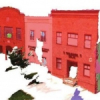Free Online Productivity Tools
i2Speak
i2Symbol
i2OCR
iTex2Img
iWeb2Print
iWeb2Shot
i2Type
iPdf2Split
iPdf2Merge
i2Bopomofo
i2Arabic
i2Style
i2Image
i2PDF
iLatex2Rtf
Sci2ools
CVPR
2010
IEEE
2010
IEEE
Piecewise Planar and Non-Planar Stereo for Urban Scene Reconstruction
Piecewise planar models for stereo have recently become popular for modeling indoor and urban outdoor scenes. The strong planarity assumption overcomes the challenges presented by poorly textured surfaces, and results in low complexity 3D models for rendering, storage, and transmission. However, such a model performs poorly in the presence of non-planar objects, for example, bushes, trees, and other clutter present in many scenes. We present a stereo method capable of handling more general scenes containing both planar and non-planar regions. Our proposed technique segments an image into piecewise planar regions as well as regions labeled as non-planar. The nonplanar regions are modeled by the results of a standard multi-view stereo algorithm. The segmentation is driven by multi-view photoconsistency as well as the result of a colorand texture-based classifier, learned from hand-labeled planar and non-planar image regions. Additionally our method links and fuses plane hypotheses acro...
Computer Vision | CVPR 2010 | Piecewise Planar | Piecewise Planar Models | Piecewise Planar Regions |
| Added | 29 Apr 2010 |
| Updated | 14 May 2010 |
| Type | Conference |
| Year | 2010 |
| Where | CVPR |
| Authors | David Gallup, Jan-Michael Frahm, Marc Pollefeys |
Comments (0)

